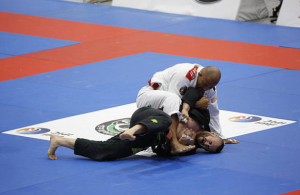(ThyBlackMan.com) The ability to protect yourself from an attacker is a vital life skill, unfortunately it is one which many people neglect. By training the most effective self defense techniques you prepare yourself for the dangers of an aggressive confrontation, improving your chances of safely removing yourself from the situation and avoiding harm.
Keep your footing and keep your distance
The biggest misconception about self defense is that it’s important to be a master of fighting on the ground. While arts like Brazilian Jiu-Jitsu feature techniques which are effective even against larger attackers, they should be a last resort. When confronted with a violent individual you should seek to avoid the ground if possible, because once you are on the ground you can not escape and are defenseless should additional attackers join in.
An effective push kick will keep you at a distance, while a strong base prevents your attacker from getting you to the ground.
1) Push Kick
Simply put, if your attacker can’t get within reach of you, they can’t get you down and put you in further danger. For an effective push kick avoid an arcing strike, as if you were kicking a ball. Instead pick your leg straight up then extending it forward to push your attacker back with the sole of your foot. A lead push kick is most effective used if your attacker is already close as it requires less space, while kicking with your back leg will create a more-powerful strike. Any time you are on the feet and not held, a push kick is a valuable self defense technique to create distance and escape.
2) Yank Counter
Whether your attacker is trying to pull you down or drag you along, it’s important to resist with a strong, wide base. When the assailant yanks on your arm step forward with one leg extending it straight and driving your weight back with that foot. Transfer as much weight as you can onto the rear leg by squatting back to counter the pull.
3) Shove Counter
If your attacker instead attempts to push you to the ground, the most effective self defense response is similar to the pull, just in reverse. Extend one leg straight back to provide a base to push off of, while driving your weight forward onto your lead leg. Remember, avoiding the ground should be your top priority so resisting the push is vital.
Break their grips immediately
When grabbed in a self defense situation, whether it’s your wrist, your throat or your hair, your first priority has to be to remove their hands. You can’t escape if your attacker doesn’t let go, so get their hands off you as quickly as possible.
An effective technique involves rotating your wrist to break free your from your attacker’s grasp.
4) Single Wrist Grip, One-Armed Break
When breaking a grip, particularly of a larger assailant, the key is to focus your strength against their weak points. To remove your wrist from an attacker’s hand you want the side of your wrist bone at the point their thumb and index finger come together. Rotate your wrist to properly align it, then raise your arm in an uppercut motion while stepping forward slightly. The rotation will help to pry their fingers apart slightly, allowing the strong wrist bone to break through the gap.
5) Single Wrist Grip, Two-Armed Break
The two-handed variety of wrist break is not as quick, but can be used in the event your attacker’s grip is too strong. Ball your fist on the arm being held, then grab underneath the fist with your second hand. Follow the same motion as the one-arm break, using your second arm to add more strength to the technique and break the hold.
Closing the arteries in your neck can render you unconscious in seconds, making a quick escape essential.
6) Two-Handed Choke Escape
With most holds an attacker can apply there will be directions they are strong and directions they are weak, and it is important to understand where each hold is weak to find an escape. When an attacker has two arms on your throat they are weakest when trying to hold you up, so to escape you should step forward and squat down while striking the underside of your attacker’s arms with your hands to pop their hands off.
7) One-Handed Choke Escape
Grip your attacker’s wrist with both hands, so that your fingers form a diamond before closing around the wrist. Step towards your attacker while bringing your outside elbow over the top of their arm, which will leave their arm extended underneath your arm. Squat down and raise the wrist to apply pressure to your attacker’s elbow.
Self defense techniques can turn an attacker grabbing your hair into an opportunity to incapacitate and escape.
8) Hair Grab Armbar Escape
The counter to an aggressor grabbing your hair is very similar to a one-armed choke defense, with some small tweaks to the technique to prevent your attacker jerking you around by your hair. Secure the attacker’s hand in place by covering it with your own, then perform the same technique as the choke to apply the arm lock.
9) Hair Grab/Choke Shoulder-Lock Escape
Although the arm lock techniques are effective if you are in a setting where subduing your attacker and calling for help is enough, if you need to create distance the shoulder-lock variant is your most effective self defense option. After securing their hand, step behind your attacker while lowering your level, then stand up tall to secure their arm in a tight shoulder lock. Shove your attacker away to create distance to escape.
What to Do When You Get Knocked Down
Unfortunately, there is no way to guarantee that a self-defense situation goes perfectly, and so it is important to be prepared for suboptimal situations. If you are knocked to the ground, knowing how to safely land, create distance and get back to your feet is vital.
These simple techniques will protect you in a fall, and help create space to safely stand back up.
10) Break Fall
Falling down is easy, but falling down correctly takes some practice. A break fall is a technique used in many grappling arts and self defense classes to protect your head and joints when being taken down. Tuck your chin to your chest round your back as you fall, seeking to land butt first. As your butt makes contact release your back but keep your chin tucked, while slapping the ground with your palms. The chin tuck keeps the back of your head from slamming off the ground, while the slaps prevent you from planting your arm with it locked out which can lead to breaks or dislocations.
11) Kick and scoot
Once on the ground your top priority should be techniques which let you create the space you need to get up while protecting yourself from strikes. Raise one hand up close to your head to protect it, which is always important in self defense scenarios, while planting the same side foot close to your butt. Using your second hand for additional balance behind you, drive back with your planted foot to scoot away from your attacker. If they approach you, use your other leg to deliver a push kick to your attacker’s knee to maintain your distance.
12) Technical Get-Up
With space established you now need to get up while still protecting yourself. Get into the same self defense stance as the kick and scoot, but instead of scooting backwards, lift your hips up off the ground. Bring your non-planted leg underneath you and plant it behind you to get into a squatted stance. Use both hands to protect your face as you stand up.
Escaping the Worst Case — Self Defense while Mounted
On your back with an attacker on your chest is an incredibly dangerous situation and you need to apply self defense techniques to get out as quickly as possible.
Escaping from mount to a more defensive position protects you from dangerous strikes.
13) Shrimping
One of the most basic and important techniques in Brazilian Jiu-Jitsu, the shrimp can be awkward at first but is an essential tool for escaping self defense situations on the ground. Turn onto one hip, then plant your other foot on the ground as close to your butt as possible. Push off of your planted foot, using it to drive your hips back. Practice shrimping in both directions without anyone on top of you to get comfortable with the movement.
14) Mounted Shrimp Escape
The most basic mount escape technique is to apply the shrimp you’ve practiced. Assist your leg by using your hands and forearms to push off of your attacker’s thigh as you shrimp. Your goal is to slide out far enough that your non-planted leg’s knee pops free. Once free, turn to your other hip and cross the leg you just freed over the leg you pushed off of.
15) Stepover Mount Escape
The stepover escape is an effective self defense technique to make more space to pull your one leg free. Turn to your hip as if shrimping then step over your attacker’s leg with your raised foot. Using the heel of the foot, scoop under your attacker’s shin and lift up while using your elbow to push out on your attacker’s thigh. This creates a gap between their knee and the floor, so slide your lower leg under it, then turn to your opposite hip and cross your legs.
Regaining Guard and Escaping to the Feet
With one leg free you should not get complacent. Keep working to full guard so you can escape.
You have now attained what is known as “half guard” but you aren’t out of danger yet. You need to get back to full guard and begin looking to escape to your feet in order to get away from your attacker. When in a self defense scenario you should always be looking to improve your position until a window to escape emerges.
16) Guard Recovery
Watch out for any possible strikes from your attacker by using the hand which matches your trapped leg to grab your attacker’s arm at the tricep. Plant your free foot on the ground near your butt and shrimp back to free your knee, then wrap it around your attacker’s midsection so that you have them secured between your legs in full guard.
From a defensive guard you can block punches and kick away your attacker.
17) Punch Defense from Guard
You should always be ready for your attacker to try to hit you in a self defense setting, particularly if they are on top of you. Do not try to catch punches. Instead, block as the strike comes down using your forearm, then wrap your arm around their punching arm to secure and trap it so they can’t try to punch you again.
18) Kick-Off to Standing
Guard is the safest position to be on your back, but it’s not better than standing up. Release the hold of your legs around your attacker’s midsection, and plant one foot in each hip. If you have secured one or more arms following a punch, release them at the same time you kick off with both legs as strong as you can, then perform a technical get-up.
Always be prepared, even for the unexpected
Not every attack will be the same, so it is also necessary to be prepared with self defense techniques for some unconventional ways an attacker may engage you, including surprise attacks. With these techniques you’ll be ready if your attacker approaches from behind, or manages to get atop your chest on the ground after catching you unaware.
It is especially important to remain composed when surprised from behind. These techniques allow you to escape even a worst case scenario of a sneak attack from behind.
19) Trip Counter to Headlock
Although being trapped in a headlock can be scary, especially if your attacker is much larger, it also provides some advantages if you know how to seize on them. When in a headlock your hips are behind your attacker and lower than his, which is bad for his balance. Technique beats size when properly applied. Lock your arms around his waist and extend your near leg behind his. Twist toward the extended leg, him over it to wrestle your attacker to the ground. Place your forearm across your attacker’s through and extend down while lifting your head and back up to break his grip and escape.
20) Leg Hook while Bear Hugged
If you’re grabbed from behind and lifted, your first priority must be to avoid being carried or thrown. As you come off the ground, wrap one leg around the outside of your attacker’s leg then tuck your foot between his legs and hook his leg at the knee. This prevents your attacker from being able to lift you further, or to walk off with you.
Your legs can deliver a great deal of force, driving your attacker off of you.
21) Escaping an Opponent on Your Chest
When your attacker is lying on your chest it can be difficult to breathe, and it is easy to panic. Remain calm and bend at the hips to bring your legs up, then bring one leg in front of your attacker’s face. Rock forward, using the leg across his face to drive down towards the ground to roll your attacker onto his back so that you can get up.
Self defense is a skill you’d much rather have than not need, than need and not have. Be sure to practice these techniques until they are second nature and you can be confident that if an aggressive individual threatens you, you will be capable and prepared to fend off their attacks.
Staff Writer; Mark Jones

















Leave a Reply